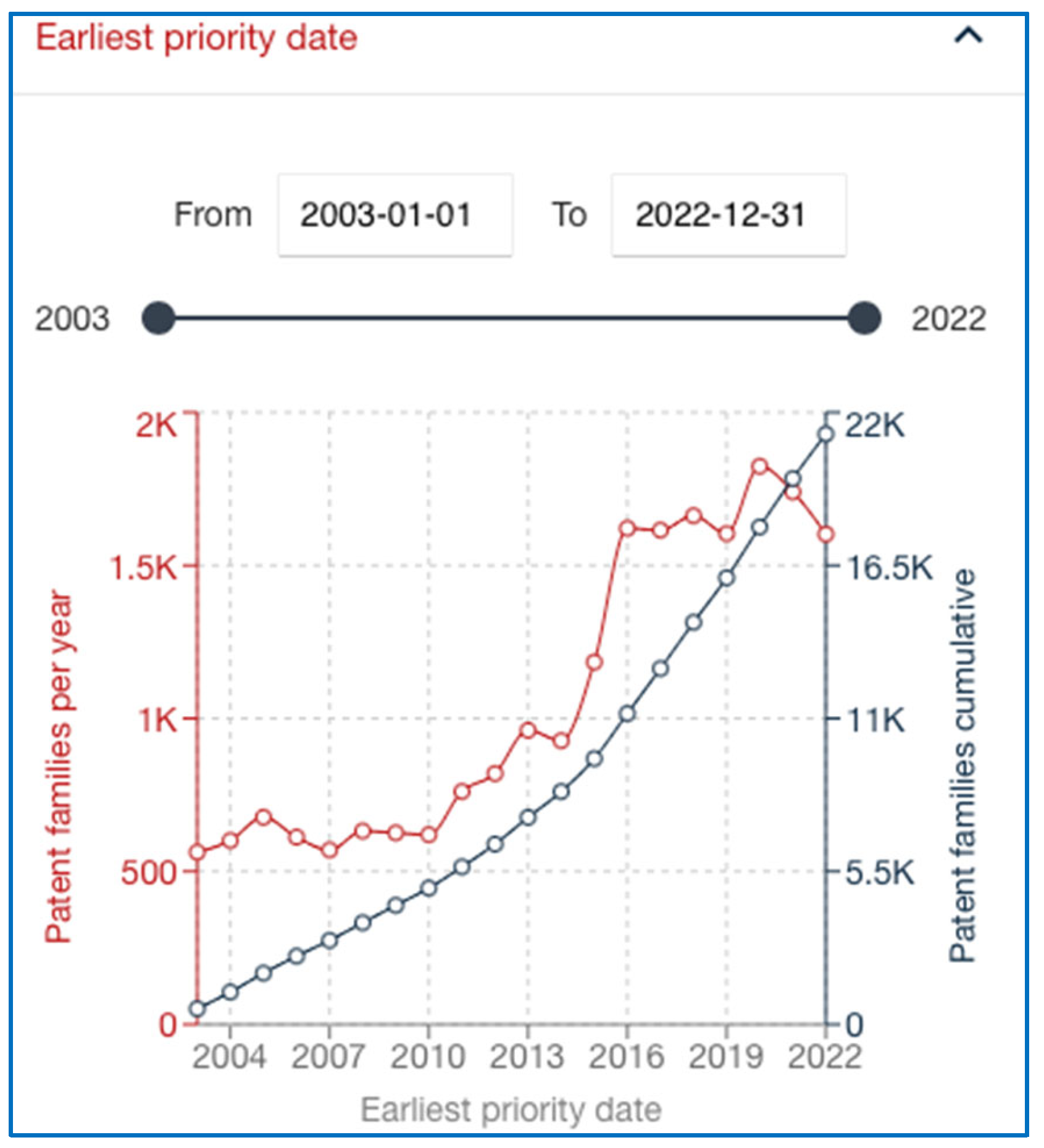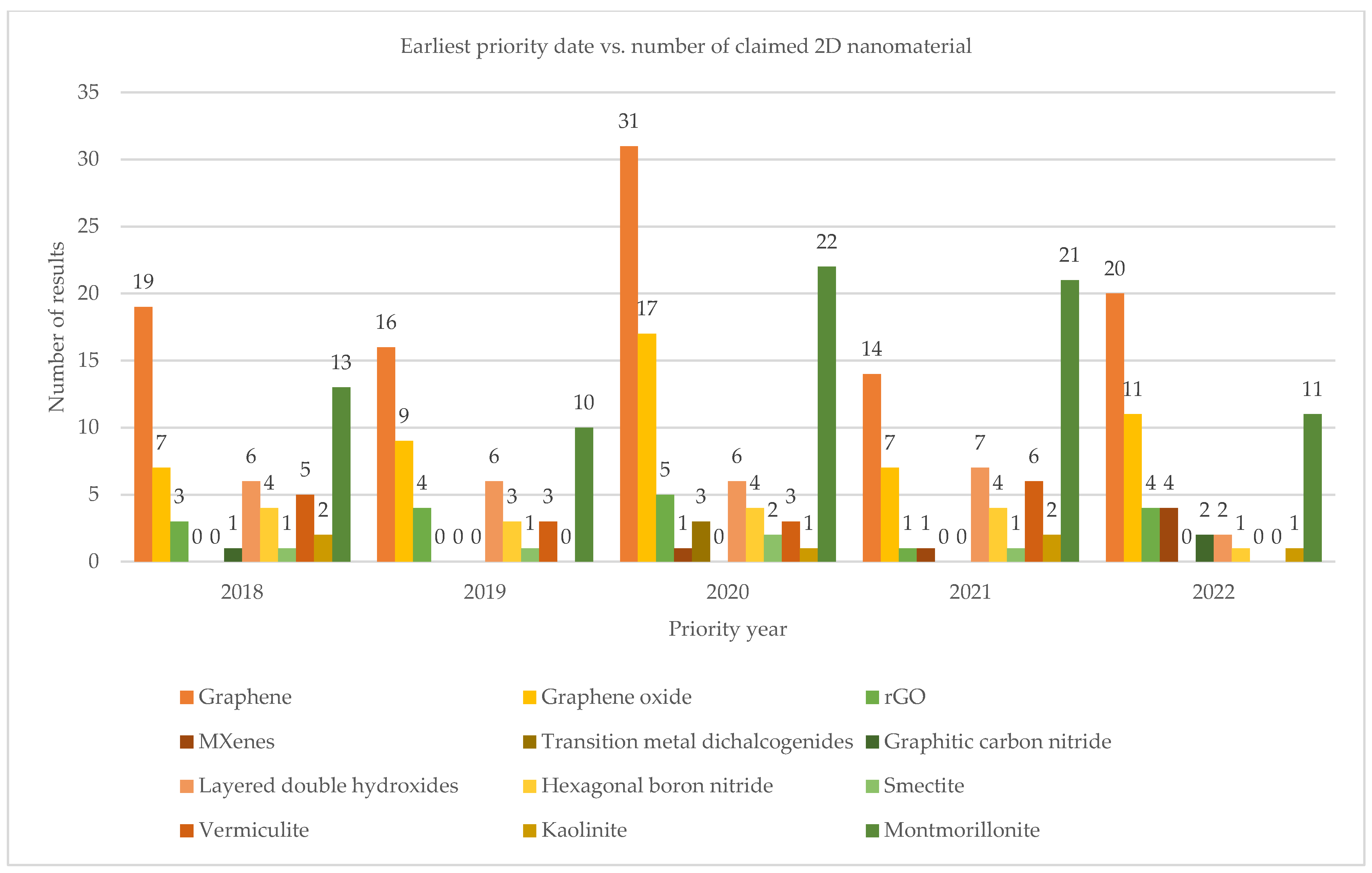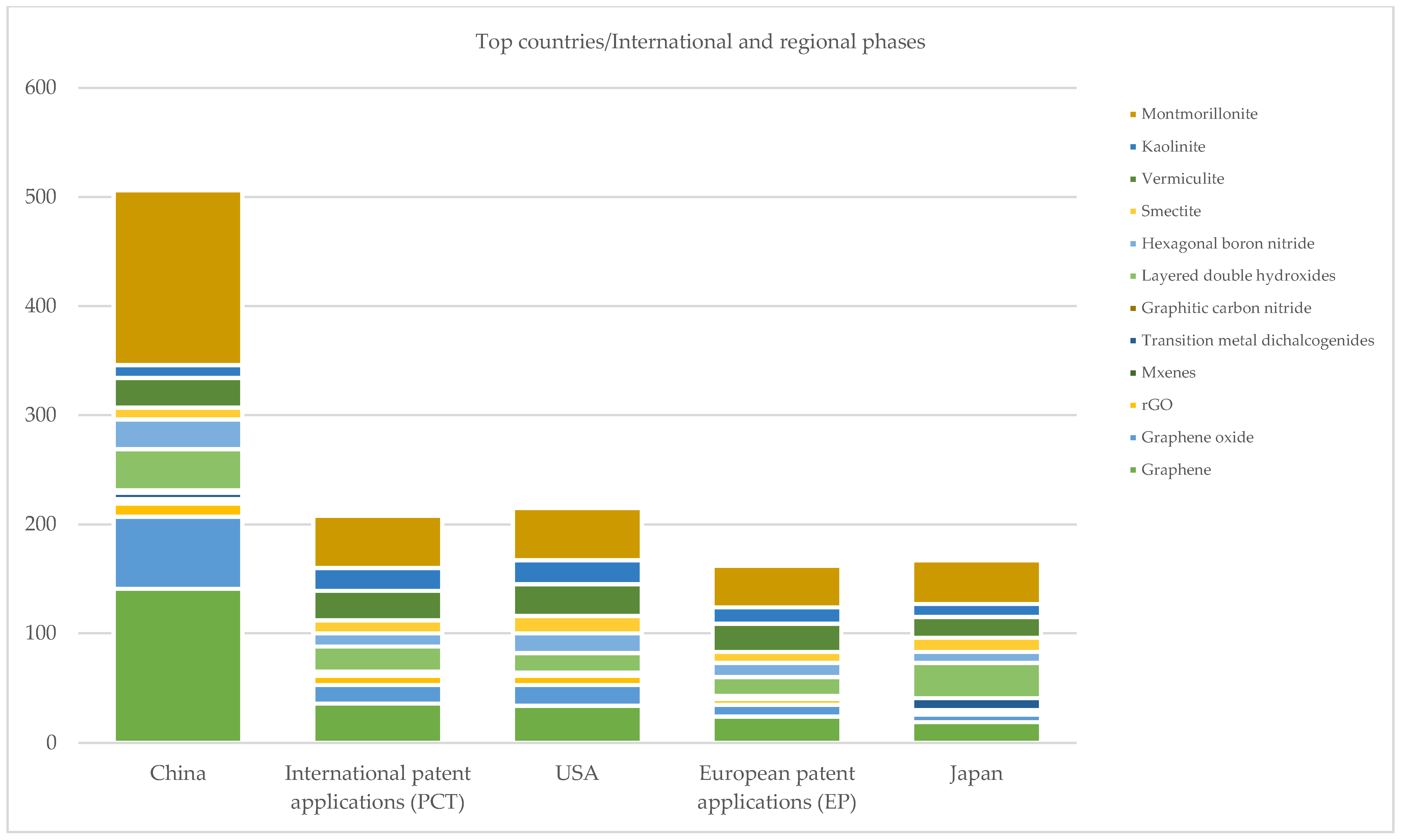Patent Analysis and Trends Related to 2D Nanomaterials for Active Food Packaging †
Abstract
1. Introduction
2. Materials and Methods
3. Results and Discussion
4. Conclusions
Funding
Institutional Review Board Statement
Informed Consent Statement
Data Availability Statement
Conflicts of Interest
Abbreviations
| GO | Graphene oxide |
| rGO | Reduced graphene oxide |
| g-C3N4 | Graphitic carbon nitrides |
| h-BN | Hexagonal boron nitride |
| LDHs | Layered double hydroxides |
| TDMs | Transition metal dichalcogenides |
| PLA | Polylactic acid |
| PVA | Polyvinyl alcohol |
| PHA | Polyhydroxyalkanoate |
| EPO | European Patent Office |
| WIPO | World Intellectual Property Organization |
Appendix A
| 2D Nanomaterial | Search Query |
|---|---|
| Hexagonal boron nitride (h-BN) | ((ctxt = (“food “prox/distance < 2 “packag*”) AND (cl all “B65D” OR cl all “B32B27” OR cl all “C08J5/18” OR cl all “A23L”)) OR cpc all “B32B2439/70” OR ((cpc all “Y02W90/10” OR cpc all “Y02A40/90” OR cpc all “A23V2002/00”) AND ctxt = (“food “prox/distance < 2 “packag*”))) AND (ctxt all “hexagonal boron nitride?” OR cl all “C01B21/064” OR cl all “C08K3/38” OR cpc all “C08K2003/385”) |
| Layered double hydroxides (LDHs) | ((ctxt = (“food “prox/distance < 2 “packag*”) AND (cl all “B65D” OR cl all “B32B27” OR cl all “C08J5/18” OR cl all “A23L”)) OR cpc all “B32B2439/70” OR ((cpc all “Y02W90/10” OR cpc all “Y02A40/90” OR cpc all “A23V2002/00”) AND ctxt = (“food “prox/distance < 2 “packag*”))) AND (ctxt all “layered double hydroxide?” OR cl all “C01F7/785” OR ctxt all “anionic clay?” OR ctxt all “hydrotalcite”) |
| Graphitic carbon nitride (g-C3N4) | ((ctxt = (“food “prox/distance < 2 “packag*”) AND (cl all “B65D” OR cl all “B32B27” OR cl all “C08J5/18” OR cl all “A23L”)) OR cpc all “B32B2439/70” OR ((cpc all “Y02W90/10” OR cpc all “Y02A40/90” OR cpc all “A23V2002/00”) AND ctxt = (“food “prox/distance < 2 “packag*”))) AND (ftxt all “graphitic carbon nitride?” OR ctxt all “g-C3N4”) |
| Transition metal dichalcogenides (TDMs) | ((ctxt = (“food “prox/distance < 2 “packag*”) AND (cl all “B65D” OR cl all “B32B27” OR cl all “C08J5/18” OR cl all “A23L”)) OR cpc all “B32B2439/70” OR ((cpc all “Y02W90/10” OR cpc all “Y02A40/90” OR cpc all “A23V2002/00”) AND ctxt = (“food “prox/distance < 2 “packag*”))) AND (ftxt all “Transition metal dichalcogenide?” OR ctxt all “molybdenum disulfide” OR ctxt all “molybdenum diselenide” OR ctxt all “molybdenum ditelluride”) |
| Graphene | ((ctxt = (“food “prox/distance < 2 “packag*”) AND (cl all “B65D” OR cl all “B32B27” OR cl all “C08J5/18” OR cl all “A23L”)) OR cpc all “B32B2439/70” OR ((cpc all “Y02W90/10” OR cpc all “Y02A40/90” OR cpc all “A23V2002/00”) AND ctxt = (“food “prox/distance < 2 “packag*”))) AND (ctxt all “graphene” OR cl =/low “C01B32/182” OR cl =/low “C08K3/042”) |
| Graphene oxide (GO) | ((ctxt = (“food “prox/distance < 2 “packag*”) AND (cl all “B65D” OR cl all “B32B27” OR cl all “C08J5/18” OR cl all “A23L”)) OR cpc all “B32B2439/70” OR ((cpc all “Y02W90/10” OR cpc all “Y02A40/90” OR cpc all “A23V2002/00”) AND ctxt = (“food “prox/distance < 2 “packag*”))) AND (ctxt = (“graphene “prox/ordered “oxide”) OR cl =/low “C01B32/198”) |
| Reduced graphene oxide (rGO) | ((ctxt = (“food “prox/distance < 2 “packag*”) AND (cl all “B65D” OR cl all “B32B27” OR cl all “C08J5/18” OR cl all “A23L”)) OR cpc all “B32B2439/70” OR ((cpc all “Y02W90/10” OR cpc all “Y02A40/90” OR cpc all “A23V2002/00”) AND ctxt = (“food “prox/distance < 2 “packag*”))) AND (ctxt = (“reduced graphene “prox/ordered “oxide”) OR ctxt all “rGO”) |
| MXenes | ((ctxt = (“food “prox/distance < 2 “packag*”) AND (cl all “B65D” OR cl all “B32B27” OR cl all “C08J5/18” OR cl all “A23L”)) OR cpc all “B32B2439/70” OR ((cpc all “Y02W90/10” OR cpc all “Y02A40/90” OR cpc all “A23V2002/00”) AND ctxt = (“food “prox/distance < 2 “packag*”))) AND (ctxt all “MXene?” OR cl all “C08K3/14”) |
| Smectite | ((ctxt = (“food “prox/distance < 2 “packag*”) AND (cl all “B65D” OR cl all “B32B27” OR cl all “C08J5/18” OR cl all “A23L”)) OR cpc all “B32B2439/70” OR ((cpc all “Y02W90/10” OR cpc all “Y02A40/90” OR cpc all “A23V2002/00”) AND ctxt = (“food “prox/distance < 2 “packag*”))) AND ctxt all “smectite” |
| Vermiculite | ((ctxt = (“food “prox/distance < 2 “packag*”) AND (cl all “B65D” OR cl all “B32B27” OR cl all “C08J5/18” OR cl all “A23L”)) OR cpc all “B32B2439/70” OR ((cpc all “Y02W90/10” OR cpc all “Y02A40/90” OR cpc all “A23V2002/00”) AND ctxt = (“food “prox/distance < 2 “packag*”))) AND ctxt all “vermiculite” |
| Kaolinite | ((ctxt = (“food “prox/distance < 2 “packag*”) AND (cl all “B65D” OR cl all “B32B27” OR cl all “C08J5/18” OR cl all “A23L”)) OR cpc all “B32B2439/70” OR ((cpc all “Y02W90/10” OR cpc all “Y02A40/90” OR cpc all “A23V2002/00”) AND ctxt = (“food “prox/distance < 2 “packag*”))) AND ctxt all “kaolinite” |
| Montmorillonite | ((ctxt = (“food “prox/distance < 2 “packag*”) AND (cl all “B65D” OR cl all “B32B27” OR cl all “C08J5/18” OR cl all “A23L”)) OR cpc all “B32B2439/70” OR ((cpc all “Y02W90/10” OR cpc all “Y02A40/90” OR cpc all “A23V2002/00”) AND ctxt = (“food “prox/distance < 2 “packag*”))) AND ctxt all “montmorillonite” |
References
- Correia, L.F.; Pinho, G.d.S.; Neves, T.J.d.C.; Vieira, K.C.d.O.; Maddela, N.R.; Prasad, R.; Winkelstroter, L.K. Nanotechnology innovation combined with bacteriocins as emerging strategy for the development of active and intelligent food packaging. Sustain. Chem. Pharm. 2024, 39, 101551. [Google Scholar] [CrossRef]
- Wallace, F.; Mittal, N.; Lambertini, E.; Nordhagen, S. Vendor Knowledge, Attitudes and Practices Related to Food Safety in Low- and Middle-Income Countries: A Scoping Review. J. Food Prot. 2022, 85, 1069–1078. [Google Scholar] [CrossRef] [PubMed]
- World Health Organization (WHO). Food Safety. Available online: https://www.who.int/news-room/fact-sheets/detail/food-safety (accessed on 28 December 2024).
- Jafarzadeh, S.; Nooshkam, M.; Qazanfarzadeh, Z.; Oladzadabbasabadi, N.; Strachowski, P.; Rabiee, N.; Shirvanimoghaddam, K.; Abdollahi, M.; Naebe, M. Unlocking the potential of 2D nanomaterials for sustainable intelligent packaging. Chem. Eng. J. 2024, 490, 151711. [Google Scholar] [CrossRef]
- Yan, M.R.; Hsieh, S.; Ricacho, N. Innovative Food Packaging, Food Quality and Safety, and Consumer Perspectives. Processes 2022, 10, 747. [Google Scholar] [CrossRef]
- Peng, B.; Qin, J.; Li, Y.; Wu, K.; Kuang, Y.; Jiang, F. Recent advances in nanomaterials-enabled active food packaging: Nanomaterials synthesis, applications and future prospects. Food Control 2024, 163, 110542. [Google Scholar] [CrossRef]
- Moustafa, H.; Hemida, M.H.; A Nour, M.; I Abou-Kandil, A. Intelligent packaging films based on two-dimensional nanomaterials for food safety and quality monitoring: Future insights and roadblocks. J. Thermoplast. Compos. Mater. 2025, 38, 1208–1230. [Google Scholar] [CrossRef]
- Yu, Y.; Zheng, J.; Li, J.; Lu, L.; Yan, J.; Zhang, L.; Wang, L. Applications of two-dimensional materials in food packaging. Trends Food Sci. Technol. 2021, 110, 443–457. [Google Scholar] [CrossRef]
- Barra, A.; Santos, J.D.C.; Silva, M.R.F.; Nunes, C.; Ruiz-Hitzky, E.; Gonçalves, I.; Yildirim, S.; Ferreira, P.; Marques, P.A.A.P. Graphene Derivatives in Biopolymer-Based Composites for Food Packaging Applications. Nanomaterials 2020, 10, 2077. [Google Scholar] [CrossRef]
- WIPO Inspire. Available online: https://inspire.wipo.int/wipo-inspire (accessed on 29 December 2024).
- Espacenet Database. Available online: https://worldwide.espacenet.com (accessed on 28 December 2024).
- Espacenet Classification. Available online: https://worldwide.espacenet.com/patent/cpc-browser (accessed on 29 December 2024).
- IPCCAT-Neural System. Available online: https://ipcpub.wipo.int/ (accessed on 29 December 2024).
- CPC Text Categorizer. Available online: https://epn.epo.org/cpc-text-categoriser (accessed on 14 February 2025).
- Liu, X.; Fei, X.; Jiang, Y. Polyester Material and Polyester Product and Preparation Methods Therefor and use Thereof. European Patent Application No. EP434988A1, 10 April 2024. Available online: https://worldwide.espacenet.com/patent/search/family/088022130/publication/EP4349881A1?q=EP4349881A1 (accessed on 14 February 2025).
- Liu, X.; Fei, X.; Jiang, Y. Rapidly Crystallized Polyester Composite Material, Molding Compound Product, and Preparation Method and Application Thereof. Chinese Patent Application No. CN114591606A, 7 June 2022. Available online: https://worldwide.espacenet.com/patent/search/family/081808470/publication/CN114591606A?q=CN114591606A (accessed on 14 February 2025).
- Wang, X.; Tang, S.; Wu, Z. High-Barrier Antibacterial Composite Film Based on Nano Cellulose/MXene Immobilized Nano Silver as well as Preparation Method and Application Thereof. Chinese Patent Application No. CN112662014A, 16 April 2021. Available online: https://worldwide.espacenet.com/patent/search/family/075401409/publication/CN112662014A?q=CN112662014A (accessed on 14 February 2025).
- Wu, Z.; Qin, X.; Wang, X.; Jin, P.; Zheng, Y. Dual-Drying Degradable Nanocellulose Composite Antibacterial Aerogel as Well as Preparation Method and Application Thereof. Chinese Patent Application No. CN115558152A, 3 January 2023. Available online: https://worldwide.espacenet.com/patent/search/family/084744262/publication/CN115558152A?q=CN115558152A (accessed on 14 February 2025).
- Zhu, Z.; Guan, Y. Polylactic Acid Modifier and Stretch-Proof high-Strength Modified Polylactic Acid. Chinese Patent Application No. CN115418089A, 2 December 2022. Available online: https://worldwide.espacenet.com/patent/search/family/084202450/publication/CN115418089A?q=CN115418089A (accessed on 14 February 2025).
- Song, J.; Chen, L.; Li, L.; Han, J.; Niu, Y. Anti-Electromagnetic Interference/Shielding Biodegradable Emulsion and Preparation Method Thereof. Chinese Patent Application No. CN114560990A, 31 May 2022. Available online: https://worldwide.espacenet.com/patent/search/family/081716474/publication/CN114560990A?q=CN114560990A (accessed on 14 February 2025).
- Lu, T.; Chen, Y.; Cai, X.; Cui, Y.; Li, M.; Di, C.; Cai, H.; Han, B. Long-Time Efficient Antibacterial Full-Degradable Medical Zinc Alloy/Polylactic Acid Composite Material and Preparation Method Thereof. Chinese Patent Application No. CN116531575A, 4 August 2023. Available online: https://worldwide.espacenet.com/patent/search/family/087457061/publication/CN116531575A?q=CN116531575A (accessed on 14 February 2025).
- Barbieri, M. Chitosan for Food Packaging Applications: A Patent Landscape Analysis. Proceedings 2024, 103, 43. [Google Scholar] [CrossRef]





| Classification Code | System | Definition |
|---|---|---|
| B65D+ | IPC/CPC | Containers for storage or transport of articles or materials |
| B32B27+ | IPC/CPC | Layered products comprising a layer of synthetic resin |
| C08J5/18 | IPC/CPC | Manufacture of films or sheets |
| Y02A40/90 | CPC | Adaptation technologies in food processing or handling: food conservation |
| A23V2002/00 | CPC (Indexing scheme) | Food compositions, function of food ingredients or processes for food or foodstuffs |
| B32B2439/70 | CPC | Food packaging |
| Y02W90/10 | CPC | Bio-packaging |
| C01B32/182 | IPC/CPC | Graphene |
| C08K3/042 | CPC | Use of carbon as compounding ingredient—Graphene or derivatives |
| C01B32/198 | IPC/CPC | Graphene oxide |
| C01B21/064 | IPC/CPC | Binary compounds of nitrogen with boron |
| C08K3/38 | IPC/CPC | Boron-containing compounds |
| C08K2003/385 | CPC | Binary compounds of nitrogen with boron |
| C01F7/785 | IPC/CPC | Hydrotalcite |
| C08K3/14 | IPC/CPC | Carbides |
| Preparation of Graphene | Corresponding IPC/CPC Symbol | No. of Results |
|---|---|---|
| CVD | C01B32/186 | 14 |
| Epitaxial growth | C01B32/188 | 1 |
| Exfoliation | C01B32/19 | 15 |
| Exfoliation—starting from graphitic oxides | C01B32/192 | 4 |
| Patent/Patent Application Number | MXene Formula |
|---|---|
| EP4349881A1 [15] | Mn+1XnTx, M is titanium and/or a combination of titanium and at least one of Sc, Y, Zr, Hf, V, Nb, Ta, Cr, Mo and W, X is carbon and/or nitrogen, n is any integral of 1–4, and Tx is -O, OH or -F. |
| CN114591606A [16] | Mn+1XnTx, wherein, M is a pre-transition metal element, and X is a carbon and/or nitrogen, n is any integer from 1 to 4, Tx is -O, -OH or -F |
| CN112662014A [17] | Ti3C2Tx |
| CN115558152A [18] | Ti3C2Tx |
| CN115418089A [19] | MXene nanosheets are titanium carbide nanosheets, titanium nitride nanosheets, titanium carbonitride nanosheets, zirconium carbide nanosheets, molybdenum carbide nanosheets, and vanadium carbide nanosheets |
| CN114560990A [20] | Ti3C2, Nb2C or Ti3AlC2 |
| CN116531575A [21] | Ti3C2Tx, Ti2CTx, Nb2CTx, Mo2CTx, Ti4N3Tx, Ta4C3Tx, V2CTx, Zr3C2Tx, (Nb0.8Zr0.2)4C3Tx |
Disclaimer/Publisher’s Note: The statements, opinions and data contained in all publications are solely those of the individual author(s) and contributor(s) and not of MDPI and/or the editor(s). MDPI and/or the editor(s) disclaim responsibility for any injury to people or property resulting from any ideas, methods, instructions or products referred to in the content. |
© 2025 by the author. Licensee MDPI, Basel, Switzerland. This article is an open access article distributed under the terms and conditions of the Creative Commons Attribution (CC BY) license (https://creativecommons.org/licenses/by/4.0/).
Share and Cite
Barbieri, M. Patent Analysis and Trends Related to 2D Nanomaterials for Active Food Packaging. Eng. Proc. 2025, 87, 9. https://doi.org/10.3390/engproc2025087009
Barbieri M. Patent Analysis and Trends Related to 2D Nanomaterials for Active Food Packaging. Engineering Proceedings. 2025; 87(1):9. https://doi.org/10.3390/engproc2025087009
Chicago/Turabian StyleBarbieri, Massimo. 2025. "Patent Analysis and Trends Related to 2D Nanomaterials for Active Food Packaging" Engineering Proceedings 87, no. 1: 9. https://doi.org/10.3390/engproc2025087009
APA StyleBarbieri, M. (2025). Patent Analysis and Trends Related to 2D Nanomaterials for Active Food Packaging. Engineering Proceedings, 87(1), 9. https://doi.org/10.3390/engproc2025087009






